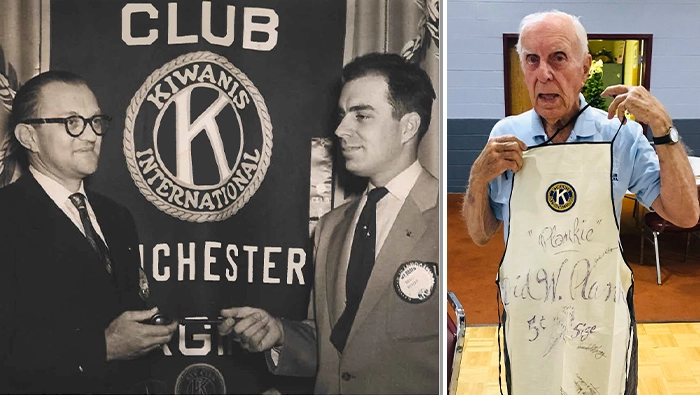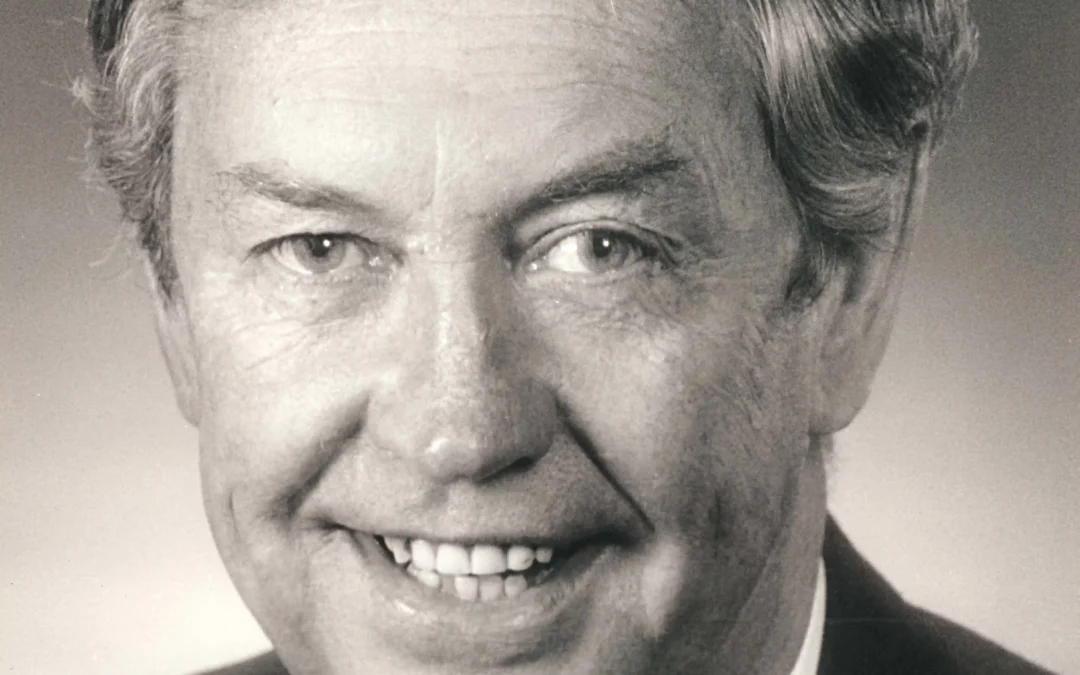
Doug Butler marks 75 years with Kiwanis
In the year of his 100th birthday, U.S. club member Butler reflects on his journey of service.
By Tony Knoderer
In the Kiwanis family, anniversaries are a big deal. It’s not uncommon for clubs to celebrate 50, 75 or even 100 years. But how often do you hear about a member reaching those milestones?
Meet Doug Butler. A member of the Kiwanis Club of Winchester, Virginia, U.S., Butler has been a Kiwanian for 75 years — and he will turn 100 in December. (In fact, his club is only two years older than he is.)
“In Winchester,” he says, “I’m known as Mr. Kiwanian.”
Like many men of his generation, Butler served in the military during World War II. When he came back, he started working in his family’s business. For professional men, it was common to join a club like Kiwanis. And back then, like today, it started simply enough — with a club member inviting someone to attend a meeting.
“The guy who worked across the street, he said, ‘Why don’t you go to lunch with me?’” Butler recalls. “He was talking about going to his Kiwanis club. I went to the meeting and thought, ‘This is pretty good for me.’”
Butler joined the club on January 1, 1949. “I got hooked on it,” he says. “I said, ‘I’ll be here every Wednesday.'”
Throwing his hat in the ring
Butler was eventually elected club president in 1955. That first step into Kiwanis leadership wouldn’t be his last, but a lot of members would recognize his path into a new role: Fellow members encouraged him to give it a shot.
“Some of them were wanting to make sure that the club leadership was varied, and they were encouraging other people to seek out officer roles,” Butler says. “They came to me and said, ‘We’d like you to be president.’”
Butler chuckles at the memory. “I told them, ‘Okay, I’ll throw my hat in the ring,’” he says. “And darned if I didn’t win.”
The start of his leadership journey may have been unexpected at the time, but his increasing commitment to Kiwanis was no accident. Even at a relatively young age, Butler was contemplating life after his career.
“I always said I wanted to retire at 50,” he remembers. “And I did. I walked out the door at 50. I started spending more time on Kiwanis projects.”
That included projects beyond his own club. One of Butler’s favorite memories, he says, is being governor of the Capital District.
“I made it a goal to visit each club in the district. That’s a great memory. I always ended up with something new. Every time I talked to a new club, they had a project they were working on — and they gave me details.”
Kiwanis International conventions are another source of fondness: “That’s given me a lot of happy memories. I especially enjoyed going to locations all over the country over the years.”
Always looking
But there was always plenty going on in Winchester, and it’s going on still. Today, Butler belongs to two clubs in town — one of which, the Kiwanis Club of Old Town, he started in 1992. (His wife, Linda, is also a member of the club.)
“I was trying to get merchants and businesspeople,” he says. “The club was convenient for people, and there are a lot of restaurants there. It worked out great.”
Opening clubs and growing membership have always been a central part of Butler’s work as a Kiwanian.
“They came to me one year and told me they’d like me to be the membership chair,” he says. “I told them I’d try — and we ended up getting 32 members in one year. I got the president that year excited about (recruiting). I brought him with me when I talked to people, and he started looking forward to it himself.”
Even now, Butler says it’s one of his favorite things about belonging to a Kiwanis club.
“I’m always looking for someone to hand an application to,” he adds. “I say to people, ‘It’s important to be a part of the community.’ I tell each person that the club has a roster, and you can see all kinds of people and professions on it, and most of them keep coming back.”
Still getting better
Needless to say, Butler has seen a lot of change in his lifetime — both in his own clubs and throughout Kiwanis. And he’s proud of that change.
“Our club has gotten better,” he says. “Especially with women coming on as members. In many cases they ended up being leaders, moving into committee chairs. And (our club) ended up with a lieutenant governor.”
For his fellow club members, Butler has long been a Kiwanian to emulate, both for his leadership and his fellowship. And, of course, for his 75 years of changing children’s lives.
Scott Straub, a member of the Winchester club, speaks for all his fellow members when he talks about Butler.
“Whether it’s Kiwanis Club Pancake Day, packing kids’ lunches for Bright Futures, ringing the bell for Salvation Army, picking up trash on the highway or doing maintenance work on the Kiwanis pavilion at the park, Doug Butler always shows up and sets the example for others to follow.
“Thanks for being such a good role model for all of these decades since 1949, Doug!”


